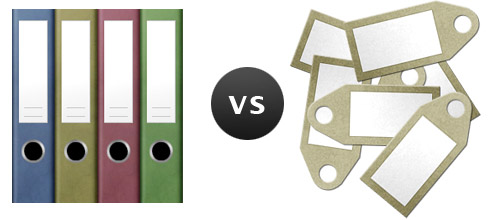
Content focused sites like blogs and online magazines have various ways to organize and sort their content. Sorting articles by date and by author is usually done automatically by the content management system. There are two concepts which can be used on top of that to organize your site’s content: categories and tags. While you can use both of them at the same time, it’s probably too much bother – so which one should you use and why? Let’s examine each one in turn.
Categories
Categories are like folders – they’re collections of things related to one theme or topic. This actually isn’t strictly true because in the digital world you can attach more than one category to your content, but the function is the same – to categorize.
The main advantage of categories is that there is a set amount of them – and if you want to utilize them properly then there shouldn’t be too many either. This lets people scan through the list quickly to choose the topic they wish to browse. Categories give your content structure and an easy browsing experience.
The downside of categories falls on the publisher. Firstly, you have to decide on the list of categories you want to use. This is usually harder than it sounds because you need to make sure there aren’t any categories which would have too many or too few posts in them. There is no point making a category if all your posts are included in it or if there is just one post. And secondly, whenever publishing new content, you need to decide which category to put it in. This isn’t too hard if you keep your category list short and assign multiple categories to content, but it still requires a little effort.
Tags
Tags are the digital equivalent of real tags – little labels you attach to things. Tags have an advantage over categories in that they aren’t pre-set. When you attach tags you write them in manually and have the freedom to write whatever you want. If a tag doesn’t exist already, it will once you’ve hit publish. There is no need to worry about finding an existing category to fit the post into – you just write the labels you feel best represent the content.
The downside of tags is in the browsing experience. One of the most popular ways to browse by tags is using something called a “tag cloud”. A tag cloud is a big block of tags listed one after another, with each tag link having its own size depending on how many items are tagged with it.
Tag clouds are great for showing what sort of entries are posted the most on the site, but browsing by tags is difficult because there are usually just too many of them. The other problem is that they’re unbalanced – there may be only entry attached to a particular tag, or there may be thousands.
OK... so which one do I use?
The answer is… it depends. It depends on what type of content you have and how your search works.
If you’ve got a site like YouTube or Flickr where users submit their own content and you have thousands or millions of submissions then categories won’t be as useful as tags because there may be thousands of entries to each category. This makes browsing very difficult and in most cases impossible. Each tag may also contain thousands of entries, but there will be many more tags with a much more focused yield of results; and using combinations of tags will also greatly narrow the number of results your visitors have to browse through.
If your site-wide search uses tags when looking through records then tags can and will add a clear benefit. If your search is something very simple, like an external Google search which simply filters results by your site address, then tags may not be as useful because they won’t be used to find the results.
I don’t think that for blogs tagging makes much sense. Sure, it may be easier to tag things, but the browsing experience isn’t that great. Sometimes you will have just one post attached to a tag – what use is that? People will generally want to find posts on a particular theme, and that’s the primary function of categories. What’s more, you’re not limited to using just one category – attach a couple if you feel the post is relevant to both.
This is just my take on tags and categories, I’m sure some of you may disagree. I’m very interested to hear whether you use tags or categories on your blogs (or both?) and why do you prefer one over the other – please do post your thoughts in the comments below.